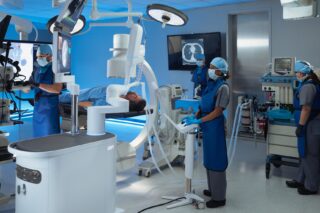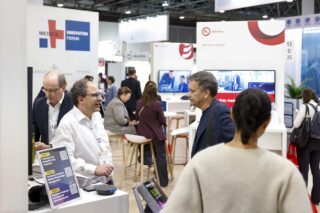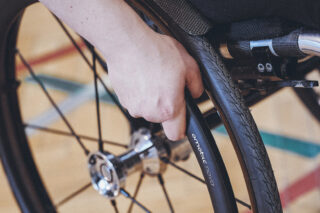A panel discussion at MEDICA 2025 highlighted the pros of genetic testing in diagnostics. Further keynotes addressed a virtual lung model and the significant role of patient communication.
17-20 November, Düsseldorf – MEDICA 2025, the annual German trade show for medical technology and healthcare solutions is soon coming to an end. The event highlighted the most recent discussions, trends and innovations in global healthcare, including data-driven care and digital transformation.
On the first conference day, the two sessions “Genomics & Precision Medicine” and “Digital Twins” shed light on questions arising from high-precision medicine and personalised therapy. Namely, virtual patient and organ models for diagnostics, treatment and drug testing were on the agenda.
Genomics and Precision Medicine: Tailoring Treatments to the Gene
In a panel session, representatives from academia, the pharmaceutical industry, and clinical practice discussed the opportunities and challenges of genomics and precision medicine. ‘There is so much data hidden in genomics’, stated Chairwoman Dr. Dr. Sandra Biskup, Managing Director and Co-founder of CeGaT (https://cegat.com), one of the very first providers of genetic diagnostics and sequencing. She argued that healthcare systems need a shift in investments, from therapy to diagnostics. “We need broad genetic testing”, she claimed.
‘Liquid biopsies Are a Problem of Cost’
Dr. Maike Raith, Medical Value Partner at Roche, agreed with her from the pharmaceutical side: ‘Liquid biopsy can give us a comprehensive view of all mutations from the organs. The evidence is there’, she emphasised. However, patients could not access it due to missing reimbursement. According to Roche, implementing diagnostic testing into clinical routine is the biggest challenge as of now. All stakeholders were in line with AI playing a supportive role in upcoming diagnostics, f.i. as part of molecular tumor boards.
Panelist Dr. Florian Markowetz, Professor for Computational Oncology at the Cancer Research Center UK from Cambridge Institute founded the diagnostics startup Tailor Bio (www.tailor.bio) focusing on chromosomal instability. He took a stand for making routine data accessible to researchers: ‘Technology is evolving much faster and clinical developments are running behind’, he criticised, claiming for better collaboration between academia and healthcare as well as standardised interfaces.
His colleague Dr. Peeter Padrik, leading cancer expert in Estonia and CEO of Antegenes, promoted risk-based personalised prostate and breast cancer screenings as prevention for men and women with high genetic risk. As he pointed out, Estonia will launch personalised breast cancer screening for over 40-year-old women as of 2026.

Digital Twins: Engineering the Future of the Human Body
In his keynote Dr. Navid Bonakdar, Chair of Medical Physical Engineering at University of Erlangen (FAU), introduced the result of a 15-years long research that could now be turned into a device for daily treatment: breatheASSIST, a medical ventilator for natural breathing using a digital twin of the individual human lung. ‘During intubation, huge pressure changes can occur in the lung when out of sync,’, he clarified: ‘with the digital model, we can now bring light into the black box of the lung and customise the lung support’, he announced proudly. This advancement was achieved in collaboration with Munich startup EBENBUILD (www.ebenbuild.com), including two clinical trials.
Making Biology Visible with Molecular Diagnosis
Another stand-out was the keynote held by Tuan Nguyen, PhD and Chief Technology Officer at AKITA, a Finnish biotechnology company developing highly scalable organ-on-a-chip platforms. Nguyen showcased PROTEINS.1, a physics-based, enzyme-free multiomics platform that can support clinicians to detect invisible biomarkers early on, based on molecular evidence. This new sensing principle could leverage day-zero diagnostics and increase survival rates from 20 to 90 percent, he estimated.
Deep Dives for Patients Through Immersive VR
Researchers from the University Hospital in Erlangen (Germany) and patients engaged together in another presentation illustrating how immersive VR experience can accelerate the adoption of innovative therapies in clinical practice. The project started in 2021 as an experimental treatment on a patient with SLE, a complex auto-immune disease.
‘The so-called CAR T-cell therapy is a day-by-day treatment path resetting the immune system, so that new B-cells can grow’, reported Norwin Kandera, a patient’s father and CEO of Onliveline (www.onxt.de). He emphasised that medical decision-making would come with greater certainty and confidence when acknowledging the important role of patient communication. To this end, deep dives through social VR journeys with gamification elements have successfully been tested in a trial with patients who received catheter therapy.

Anna Engberg
By Anna Engberg. Based in Germany, Anna Engberg is a versed digital health freelance journalist who consistently contributes to MedicalExpo e-Magazine.











